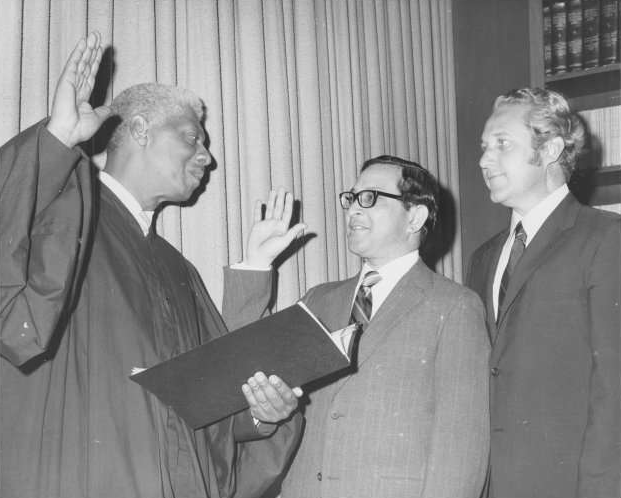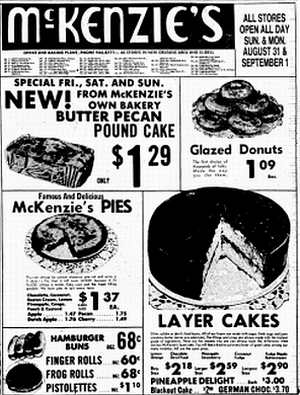|
Today in New Orleans History |
|
|
August 29


 To receive an update for each day in New Orleans history,
join our facebook page - Today in New
Orleans History.
August 29 will never pass without remembrances of our first awareness that our city
and metropolitan area were underwater in the aftermath of Hurricane Katrina. This date should never pass without a pause
to honor the memory of all who were lost that day. And to remember or try not to remember all else that was lost.
Near the bottom of this page is a time-line of the events which occurred on August 29, 2005. If you choose not
to "go there" (literally or figuratively) stop reading when you reach the bottom section. Israel Meyer Augustine, Jr., the first African American district judge in Louisiana, was born in New Orleans on November
16, 1924. His father served as principal of McDonogh No. 86 High School at 656 S. Rampart St.
Israel Jr. was a graduate of McDonogh 35 High School and received a B. A. from Southern University in Baton Rouge.
He obtained his law degree from Lincoln University in St. Louis, Missouri. In 1951, he was admitted to the Louisiana Bar
and in 1962, he was allowed to practice before the Supreme Court. In 1970, Israel M. Augustine, Jr. became the first
Black elected as judge in Criminal District Court. In 1971, he presided over the Black Panther Trial, a case that brought
him national attention. A champion of the people, Augustine established several community programs such as "Roots"
Home Coming Program, the First Offender and Angola Awareness. Judge Augustine died on August 29, 1994 of
Lou Gehrig's disease/ALS and is buried in Mount Olivet Cemetery. (Photo and text from the New Orleans Public Library) The
former Samuel J. Peters school at 245 South Broad Street was renamed for Judge Israel as was the nearby Orleans Criminal District
Court at Tulane Avenue and S. Broad Street in 1996.  To receive an update for each day in New Orleans
history, join our facebook page
- Today in New Orleans History
Victor Hugo "Vic" Schiro was born in Chicago, Illinois
on May 6, 1904, the son of Italian immigrants Andrew Edward and Mary (Pizzati) Schiro was the mayor of New Orleans from
1961 - 1970. After moving to New Orleans with his parents as a child, Schiro spent his young adulthood in Honduras and California,
where he worked as a movie extra, and co-managed a Nevada gold mine before returning to New Orleans. He worked briefly as
an assistant cameraman for Frank Capra. Having returned to New Orleans in 1928, Schiro became a radio announcer. In 1932,
Schiro married Mary Margaret Gibbes, better known as Sunny Schiro. Schiro founded his own insurance company and became an
active civic leader in the 1940s; he was president of the Young Men’s Business Club. In 1950, he was elected commissioner
of public buildings and parks. Under the new mayor-council charter of 1954, Schiro was elected councilman-at-large. When
DeLesseps S. "Chep" Morrison, resigned his position as mayor in 1961 to become U.S. Ambassador to the Organization
of American States, the City Council elected Councilman Schiro, then Councilman-At-Large, as interim mayor. Schiro was subsequently
elected to two full terms in 1962 and 1965. Schiro inherited Morrison’s Crescent City Democratic Association, formed
as a rival to the Regular Democratic Organization, but the political machine was deeply divided by the 1962 election, and
it declined thereafter. Schiro held to a simple governing philosophy, stating that "if it’s good for New Orleans,
I’m for it." In January 1961 a meeting of the city's white business leaders publicly endorsed desegregation
of the city's public schools. That same year Victor H. Schiro became the city's first mayor of Italian-American ancestry.
Mayor Schiro considered the arrival of the New Orleans Saints professional football team and the beginning of plans to build
the Louisiana Superdome to be two of the foremost achievements of his administration. He passed away on August
29, 1992.
Monday, August 29, 2005 At 5:10 AM CDT (1010 UTC), Hurricane Katrina made its second landfall as a strong Category 3 hurricane near
Buras-Triumph, Louisiana, with sustained winds of more than 125 mph (205 km/h), although Category 4 winds may have
briefly affected the area. Katrina also made landfall in St. Bernard parish and St. Tammany parish as a Category 3
hurricane for a total of three landfalls in Louisiana By 8:00 AM CDT (1300
UTC), in New Orleans, water was seen rising on both sides of the Industrial Canal. At
approximately 8:14 AM CDT (1314 UTC), the New Orleans office of the National Weather Service issued a Flash Flood Warning
for Orleans Parish and St Bernard Parish, citing a levee breach at the Industrial Canal. The National Weather Service predicted
three to eight feet of water and advised people in the warning area to "move to higher ground immediately." At about 9:00 AM EDT, reports from inside the Superdome were that part of the roof was "peeling off,"
daylight could be seen from inside the dome, and rain was pouring in. The Associated Press stated there were two holes,
"each about 15 to 20 feet (6.1 m) long and 4 to 5 feet (1.5 m) wide," and that water was making its
way in at elevator shafts and other small openings. By 9:00 AM
CDT (2100 UTC), there was 6–8 feet of water in the Lower Ninth Ward. At
10:00 AM CDT (1500 UTC), Hurricane Katrina made its third landfall near Pearlington, Mississippi and Slidell, Louisiana, with
sustained winds of 120 mph (193 km/h) after crossing Breton Sound. Also at 10:00 AM. while at a Medicare event in
El Mirage, Arizona, President Bush said, "I want to thank the governors of the affected regions for mobilizing assets
prior to the arrival of the storm to help citizens avoid this devastating storm." By 11:00 AM CDT (1600 UTC), there was approximately 10 feet (3 m) of water in St. Bernard Parish. Many
rooftops could not be seen here as they were submerged. Therefore, there was much more than 10 feet (3.0 m) of water
in many places. At 2:00 PM CDT (1900 UTC), New Orleans officials confirmed
a breach of the 17th Street Canal levee There was also confirmation of breaches at two other canals. In a press conference at 3:00 PM CDT (2000 UTC), New Orleans Homeland Security Director Terry Ebbertt
stated that he was positive that there were casualties resulting from the storm, based on calls to emergency workers from
people trapped in trees and homes. He said that, "Everybody who had a way or wanted to get out of the way of this storm
was able to. For some that didn't, it was their last night on this earth." Police were fanning out across the city
to assess damage, rescue people, and get a good look at the situation before nightfall. The hardest-hit areas of the city
were the Lower Ninth Ward, New Orleans East, Gentilly, Lakeview, St. Bernard parish, and Plaquemines parish. Governor Blanco ordered 68 school buses into New Orleans from surrounding parishes to begin evacuating
any survivors that remained in the city. 6908 Army National Guard and 933 Air National Guard were deployed (7,841 total).
Governor Blanco and the National Guard stated that they could "handle it". FEMA Director Michael Brown also urged
local fire and rescue departments outside Louisiana, Alabama, and Mississippi not to send trucks or emergency workers into
disaster areas without an explicit request for help from state or local governments. Brown sought the approval from Homeland
Security Secretary Michael Chertoff five hours after landfall to dispatch 1,000 Homeland Security workers into the region.
Brown acknowledged that this process would take two days. He described Katrina as a, "near catastrophic event." Brown defined the role of requested assigned personnel and additional aid from the
United States Department of Homeland Security: "Establish and maintain positive working relationships with disaster
affected communities and the citizens of those communities. Collect and disseminate information and make referrals for appropriate
assistance. Identification of potential issues within the community and reporting to appropriate personnel. Convey a positive
image of disaster operations to government officials, community organizations and the general public. Perform outreach with
community leaders on available Federal disaster assistance." President
Bush declared a major disaster for Louisiana, Mississippi,and Alabama,under the authority of the Stafford Act. From
http://en.wikipedia.org/wiki/Timeline_of_Hurricane_Katrina |
|
|

To receive an update for each day in New Orleans history,
join our facebook page - Today in New
Orleans History.
Analytics |






